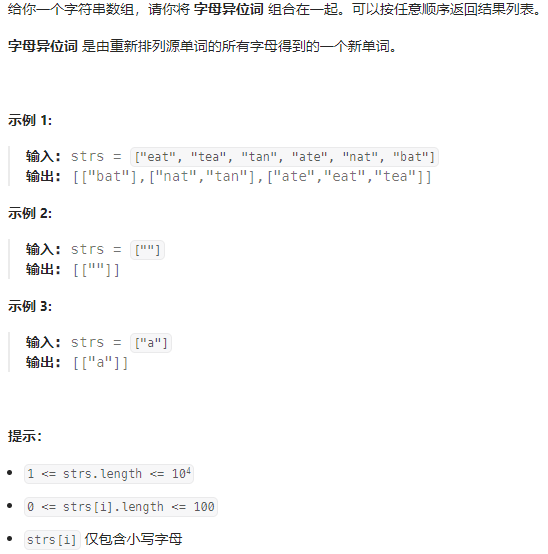字母异位词分组
1、题目
 image-20240201205948099
image-20240201205948099
2、题解
由题意可知,字母异位词的共同特点是含有相同的字母,因此可以用哈希表存储一组字母异位词。遍历字符串,得到每个字符串所包含的标志并加入该字母异位词的列表。遍历完成后哈希表的值即为一组字母异位词列表。
解法一:排序
1
2
3
4
5
6
7
8
9
10
11
12
13
14
15
16
17
18
19
20
21
22
23
24
25
26
27
28
|
class Solution:
def groupAnagrams(self, strs: List[str]) -> List[List[str]]:
mp = collections.defaultdict(list)
for st in strs:
key = "".join(sorted(st))
mp[key].append(st)
return list(mp.values())
def add_dict(dictionary, key, value):
if key not in dictionary:
dictionary[key] = []
dictionary[key].append(value)
return dictionary
def group_anagrams(ip_str):
mp = {}
for st in ip_str:
key = "".join(sorted(st))
mp = add_dict(mp, key, st)
return list(mp.values())
|
解法二:记数
由于互为字母异位词的两个字符串包含的字母相同,因此两个字符串中的相同字母出现的次数一定是相同的,故可以将每个字母出现的次数使用字符串表示,作为哈希表的键。
1
2
3
4
5
6
7
8
9
10
11
12
13
| class Solution:
def groupAnagrams(self, strs: List[str]) -> List[List[str]]:
mp = collections.defaultdict(list)
for st in strs:
counts = [0] * 26
for ch in st:
counts[ord(ch) - ord("a")] += 1
mp[tuple(counts)].append(st)
return list(mp.values())
|
